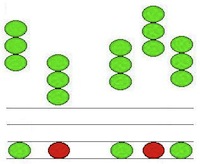
HARMONIC EXPANSIONS
CHAPTER 2: NONHARMONIC TONES
2.11 Pedals (Pedal Points, Pedal Tones)
 |
 |
 |
In the next-to-the-last measure of Bach's Prelude in C from Book One of The Well Tempered Clavier, the bass note C, sustained for all four beats, does not belong to the G7 harmony of the right hand. This non-harmonic tone, most concisely called a "pedal," is unusual in that it usually appears in the bass. It is approached and left by the same note. In fact see the bass note C in every measure of the excerpt.
The C under the IV chord in the first measure of the last line is also considered a pedal because it forms a dissonant perfect fourth with the F's above it. In a strict sense this C is not nonharmonic; it does in fact belong to the accompanying F chord, but it is included here as a nonharmonic tone because it creates a dissonance which must be resolved. The resolution of both these pedal tones arrives with the E in the final tonic chord in the last measure. The C, as a pedal, never moves.
|
In general a pedal, or "pedal point" or "pedal tone," is a note that stays stationary while harmonies in other voices change. It is a nonharmonic pedal tone whenever it does not belong to a simultaneously sounding harmony. Exception: If the bass of a second inversion chord is approached and left by the same pitch and if an upper voice resolves the dissonant fourth to a third, then this bass note is also called a pedal. This despite the fact that it is a member of the chord. |

|
| In four voices on page 1.2 the primordial tonic was analyzed as having been expanded by two lower neighbors, but this expansion could just have easily been analyzed as a dominant triad in the upper three voices over a tonic pedal. | |
| In the video to the left, there is the same ambiguity as on the top of page 1.2--Are two lower neighbors expanding an E minor triad or is a tonic pedal accompanying the dominant triad, B major, in the upper voices? In general the answers to questions like these depend on the context in a particular piece, the ear of the individual listener, and as we shall see in Chapter 3, the level of analysis. | |
| Pedals can be shown more clearly in 4 voices with the insertion of a ii° chord before the dominant (The use of ii before the dominant will be covered in Chapter 4). In the video to the right, the tonic E pedal is not a member of the ii° and V chords. The resolution occurs not with the movement of the nonharmonic tone, but with the progression to a tonic triad in the upper three voices. | |
 |
 |
 |
 |
Comments? Click here. |



